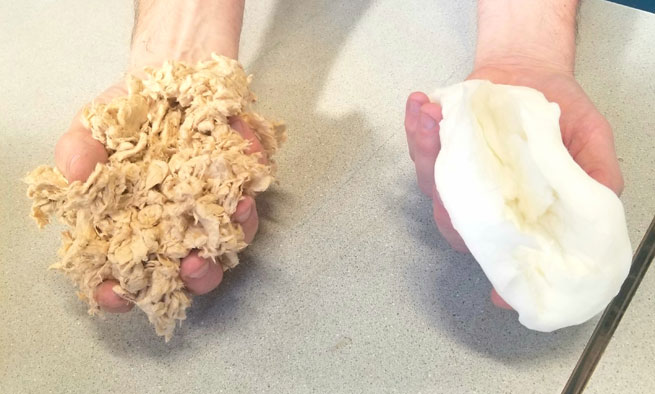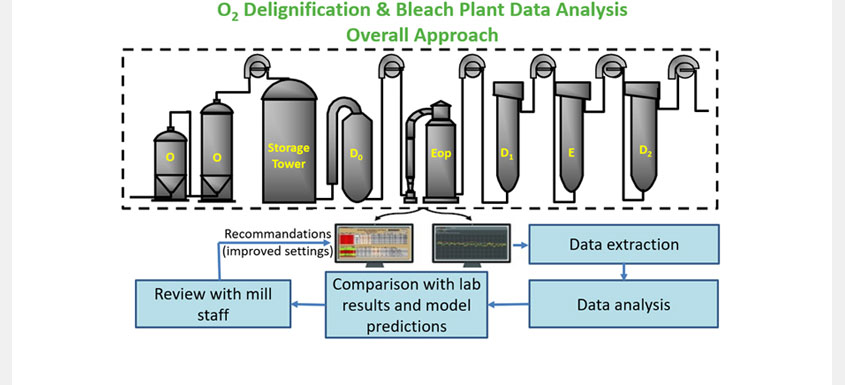It is no secret that kraft fibreline equipment in North American kraft mills is getting old. Mills are upgrading their machines and looking for ways to improve their operations to become more efficient and cost-effective.
To stay competitive against state-of-the-art operations around the world, new bleaching strategies and solutions for aging kraft pulp mills are crucial. In addition, the complexities of kraft fibreline chemistry can sometimes lead to severe bleachability issues and increased costs. To help kraft pulp mills maintain a stronghold in the market and address their issues, current research on fibreline chemistry by FPInnovations’ Shree-Prakash Mishra and the Pulp and Paper Manufacturing – Chemical Process team has been focusing on each stage of the bleaching process.
Top concern: cost-effectiveness
Kraft mills are seeking help to either upgrade their assets for more stable and smooth operation, or to replace inefficient or damaged equipment. Regardless of the improvement of choice, cost-effectiveness remains a significant criterion to ensure that the mill achieves its benchmark targets.
With a shrinking workforce, it is even more important that any modifications on the fibreline are regularly monitored and benchmarked. It is also as important to compare the impact of the modifications on the chemical and operational costs with previous targets, lab results, model predictions from lab results, and surveys.
FPInnovations has therefore introduced a data driven approach to process analysis. Using various software tools, mill process data is collected, analyzed to establish trends, and compared to various benchmarking data in order to identify opportunities and offer cost-effective solutions.
FPInnovations’ Chemical Process group is able to identify a variety of improvement opportunities and provide solutions to our member mills.
Cost reduction opportunities during oxygen delignification and bleaching operations
The different unit operations in a fibreline process are interconnected: from wood chip handling, to pulping, oxygen delignification, and finally the bleach plant. Any issue with any of the steps in a unit operation can have a significant impact on the overall fibreline performance.
 Unbleached pulp versus bleached pulp
Unbleached pulp versus bleached pulp
To provide an effective solution, the problem must first be identified.
FPInnovations’ Chemical Process group takes a holistic approach to get to the root of the issue. The team first analyzes the entire fibreline to fully understand the downstream processes and their impact on the bleaching operation.
The problem is sometimes related to the lack of proper control in a specific section of the unit operation. To address such issues, fibreline specialists within FPInnovations’ Controls group are able to provide advice and assistance to the mill.
In fact, in one scenario, the team demonstrated that a feedback control strategy in the extraction stage helped a mill achieve sustained caustic savings at a lower caustic to ClO2 ratio, which was identified by the mill process data analysis and lab evaluations. With FPInnovations’ recommendations the mill was able to save approximately $750,000 per year.
Problems are also sometimes related to the percent distribution of a particular chemical (such as chlorine dioxide) in the different stages of bleaching, or related to the effectiveness of a particular chemical (such as hydrogen peroxide) at a particular stage in bleaching. In both cases, a laboratory evaluation could provide a cost-effective solution to the mill.
How process data analysis can help
Each mill has its own operational strategies and performance metrics. Historical process data analysis is helpful in revealing the performance of an implemented proprietary technology in the mill, such as FPInnovations’ Near Neutral Brightening (NNB) or Papricycle.
In one case study, FPInnovations found that implementing NNB resulted in achieving the final brightness with a significant decrease in variability in the final D2 stage and machine brightness, despite poor caustic dosage control in the extraction stage.
In another case study where a mill had implemented FPInnovations’ Papricycle technology in one of its fibreline operations, analysis of historical data revealed that, along with significant savings in E1 caustic, the mill was also saving D1 chlorine dioxide.
Substantial potential savings
Over the years, FPInnovations’ research and expertise in process chemistry, data analysis, and process control have helped kraft pulp mills reduce their bleaching costs typically by $500,000 to $1M per year.
Currently, the team is working on helping the mills by offering solutions based on mill process data analysis and laboratory evaluation. Ongoing research, alongside member collaboration, will continue to advance bleaching improvements and help pulp mills to adapt to changing wood baskets as well as to a continuously shifting market.
For more information about this project, please contact Shree-Prakash Mishra, Senior Scientist, at
Source: FPInnovations













